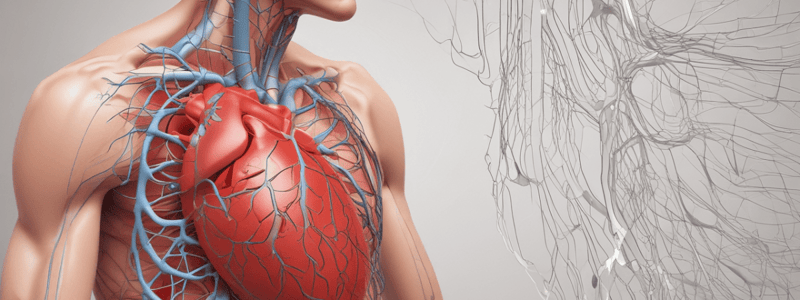Podcast
Questions and Answers
What determines the direction of blood flow in the circulatory system?
What determines the direction of blood flow in the circulatory system?
- Cardiac output
- Pressure gradient (correct)
- Stroke volume
- Total peripheral resistance
What is the relationship between flow rate and cardiac output?
What is the relationship between flow rate and cardiac output?
- Flow rate is equal to cardiac output
- Flow rate is directly proportional to cardiac output (correct)
- Flow rate is inversely proportional to cardiac output
- Flow rate is independent of cardiac output
In which part of the circulatory system is the pressure drop the greatest?
In which part of the circulatory system is the pressure drop the greatest?
- Arteries
- Arterioles (correct)
- Venules
- Capillaries
What is the relationship between velocity and area of blood vessels?
What is the relationship between velocity and area of blood vessels?
What is the unit of measurement for cardiac output?
What is the unit of measurement for cardiac output?
What is the formula for blood pressure?
What is the formula for blood pressure?
What is the formula for calculating resistance in the vascular system?
What is the formula for calculating resistance in the vascular system?
Which of the following conditions would increase viscosity in the vascular system?
Which of the following conditions would increase viscosity in the vascular system?
What is the main reason why capillaries have low resistance?
What is the main reason why capillaries have low resistance?
Which type of flow is characterized by being smooth and in a straight line?
Which type of flow is characterized by being smooth and in a straight line?
What is the formula for calculating mean arterial pressure (MAP)?
What is the formula for calculating mean arterial pressure (MAP)?
What is the primary function of the pulse?
What is the primary function of the pulse?
What is the main factor that affects resistance in arterioles?
What is the main factor that affects resistance in arterioles?
What is the unit of measurement for blood pressure?
What is the unit of measurement for blood pressure?
Flashcards are hidden until you start studying
Study Notes
Blood Flow
- Blood flow is driven by a pressure gradient, with a major pressure drop in arteries leading to a drop in pressure by the time the blood reaches the capillaries.
- Low pressure is present in the venule system.
- Flow is directly proportional to the change in pressure and inversely proportional to resistance.
- Blood flows from high to low pressure.
Blood Pressure
- Blood pressure is determined by the pressure difference, which is the product of cardiac output (CO) and total peripheral resistance (TPR).
- CO is the total volume of blood pumped out of the ventricles per minute, calculated by heart rate x stroke volume.
- Stroke volume is the total volume of blood in ml pumped out of the ventricles for every 1 beat, approximately 4900ml or 5L/minute.
- Cardiac output is the total volume of blood pumped out of the ventricles per minute.
Cardiac Output, Flow, Velocity, and Area
- Cardiac output is measured in ml/minute.
- Flow rate is equal to cm3/minute or ml/minute.
- Velocity is measured in cm/min or calculated as Flow/area.
- Velocity is directly proportional to flow and inversely proportional to area.
- When the area of the capillaries is high, the velocity of blood travelling through them is low.
Resistance
- Resistance is calculated by dividing pressure difference by CO or flow.
- Poiseuille's equation is used to calculate resistance, which is influenced by viscosity, length, and radius of the vessel.
- Viscosity is increased in polycythemia and dehydration, and decreased in anemia.
- Length of the vessel is increased with weight and height.
- Radius of the vessel is increased in vasodilation and decreased in vasoconstriction.
Resistance in Series and Parallel Vascular Circuits
- Normal blood pressure is 120/80 mmHg.
- Series and parallel circuits are needed to maintain blood pressure.
- Capillaries have low resistance due to their parallel arrangement.
- Arterioles have the highest resistance due to their ability to change diameter through vasodilation and vasoconstriction.
Types of Flow
- Laminar flow is smooth, silent, and has low resistance.
- Turbulent flow is chaotic, noisy, and has high resistance.
- Differences in flow properties allow for blood pressure management.
Blood Pressure
- Pressure is calculated as force/unit area.
- Blood pressure is the force exerted by blood on the vessels.
- Systolic blood pressure (SBP) is the pressure in arteries during systole, approximately 120 mmHg.
- Diastolic blood pressure (DBP) is the pressure in arteries during diastole, approximately 80 mmHg.
- Pulse pressure (PP) is the difference between SBP and DBP, approximately 40 mmHg.
- Mean arterial pressure (MAP) is calculated as 2/3 DBP + 1/3 SBP, approximately 93.3 mmHg.
Pulse
- Pulse is created by the expansion and recoiling of arteries.
- Pulse indicates heart rate.
- Pulse is most readily measured at the radial artery.
- Pulse is recorded as beats per minute.
- Both the rate and strength of the pulse are important clinically.
Blood Pressure Measurement
- Blood pressure is measured in mmHg.
Studying That Suits You
Use AI to generate personalized quizzes and flashcards to suit your learning preferences.




